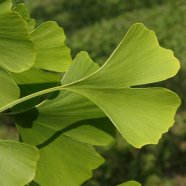interesting facts of nature: Ginkgo

 I’ve dug in the last days, going through my archive and looked at what are the topics that you again bring up recent posts. In doing so, I stumbled back to the section “interesting facts”, where, of course, also informative posts on topics such as back pain or (the not-so-positive) cystitis. So, let’s get to work and a new article written. By chance, I came across the topic of “Ginkgo” and have researched them a little. Anyone dealing with herbal remedies and natural medicine, is found very soon on a tree that has gained in recent years on the German healthcare market is becoming increasingly important. The speech is from the Ginko biloba, that originally in China and the other Asian space-based ancient tree that is already appreciated for centuries as a medicinal plant. Since a little over 200 years this exotic species already grow in Germany, because their adaptability is enormous.
I’ve dug in the last days, going through my archive and looked at what are the topics that you again bring up recent posts. In doing so, I stumbled back to the section “interesting facts”, where, of course, also informative posts on topics such as back pain or (the not-so-positive) cystitis. So, let’s get to work and a new article written. By chance, I came across the topic of “Ginkgo” and have researched them a little. Anyone dealing with herbal remedies and natural medicine, is found very soon on a tree that has gained in recent years on the German healthcare market is becoming increasingly important. The speech is from the Ginko biloba, that originally in China and the other Asian space-based ancient tree that is already appreciated for centuries as a medicinal plant. Since a little over 200 years this exotic species already grow in Germany, because their adaptability is enormous.
In the leaves, the strength is
The leaves of the Ginkgo biloba, is quite distinctive in the typical form of a fan, contain valuable ingredients. They are processed to high-quality products, which are an integral part of the phytotherapy, herbal medicine so, and many therapies are based, for example, in the area of dementia and Alzheimer’s. After harvesting, the leaves are crushed and in the process dried, in which the ingredients remain intact. In other manufacturing processes, these can now be processed, extracted and finished drugs. The only supplements you should use and the production of home-made teas from the leaves refuse, since, otherwise, undesirable ginkgolic acids to be included, which were reduced in finished products. These standardized preparations comply with the requirements of the regulatory authority for herbal medicines.
Ginkgo preparations for individual therapy
The main area of application of the Ginkgo preparations are concentration disorders, loss of memory and aging, which are mainly due to blood circulation disorders, and the decline and damage of brain cells. Ginkgo biloba can promote brain blood circulation, and thus, for adequate Transport of nutrients and oxygen to the cells. The contained flavonoids and terpene lactones are also used to combat free radicals and to prevent, among other things, nerve damage.
The Ginkgo-based drugs are in different dosages available, from 40 mg to 240 mg is the usual product range covers models from different manufacturers. Therefore, therapies can be designed very individually. Also, the intake period will vary depending on the clinical picture and should be discussed with the treating physician as well as a planned concomitant use of drugs with anticoagulant effect. More info on the Ginkgo under http://www.docjones.de/wirkstoffe/ginkgo-biloba.
Image: Maria Lanzmaster / Pixelio.de
